翻译常用之八大技negation讲义
- 格式:ppt
- 大小:373.50 KB
- 文档页数:11
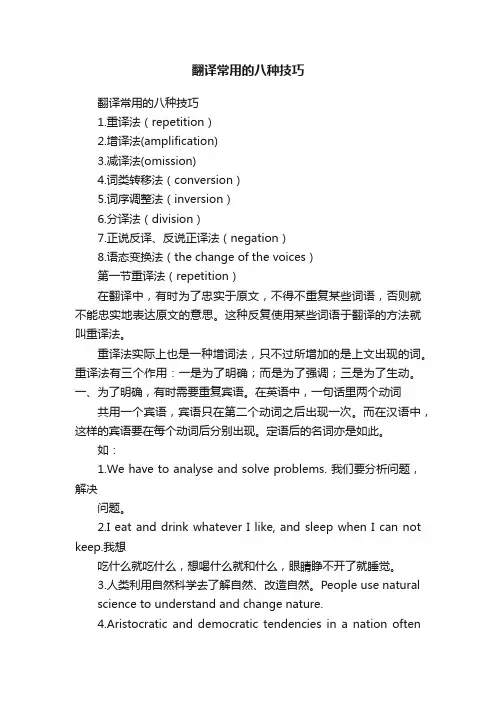
翻译常用的八种技巧翻译常用的八种技巧1.重译法(repetition)2.增译法(amplification)3.减译法(omission)4.词类转移法(conversion)5.词序调整法(inversion)6.分译法(division)7.正说反译、反说正译法(negation)8.语态变换法(the change of the voices)第一节重译法(repetition)在翻译中,有时为了忠实于原文,不得不重复某些词语,否则就不能忠实地表达原文的意思。
这种反复使用某些词语于翻译的方法就叫重译法。
重译法实际上也是一种增词法,只不过所增加的是上文出现的词。
重译法有三个作用:一是为了明确;而是为了强调;三是为了生动。
一、为了明确,有时需要重复宾语。
在英语中,一句话里两个动词共用一个宾语,宾语只在第二个动词之后出现一次。
而在汉语中,这样的宾语要在每个动词后分别出现。
定语后的名词亦是如此。
如:1.We have to analyse and solve problems. 我们要分析问题,解决问题。
2.I eat and drink whatever I like, and sleep when I can not keep.我想吃什么就吃什么,想喝什么就和什么,眼睛睁不开了就睡觉。
3.人类利用自然科学去了解自然、改造自然。
People use naturalscience to understand and change nature.4.Aristocratic and democratic tendencies in a nation oftenshowthemselves in its speech.民族的贵族倾向和民族倾向常在其言语中表现出来。
5.我们来修改安全规则和卫生规则吧。
Let’s revise our safety andsanitary regulations.二、英语常用省略,但为了明确,也为了强调某些内容,在汉语中常常要将省去的部分重译出来。
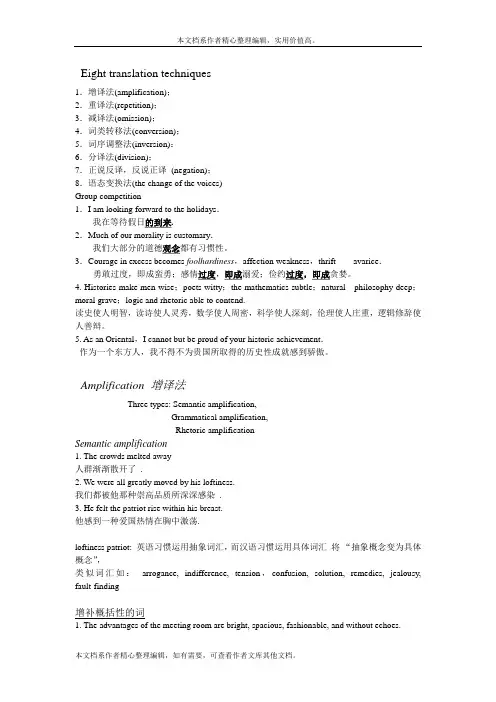
Eight translation techniques1.增译法(amplification);2.重译法(repetition);3.减译法(omission);4.词类转移法(conversion);5.词序调整法(inversion):6.分译法(division);7.正说反译,反说正译(negation);8.语态变换法(the change of the voices)Group competition1.I am looking forward to the holidays.我在等待假日的到来.2.Much of our morality is customary.我们大部分的道德观念都有习惯性。
3.Courage in excess becomes foolhardiness,affection weakness,thrift avarice.勇敢过度,即成蛮勇;感情过度,即成溺爱;俭约过度,即成贪婪。
4. Histories make men wise;poets witty;the mathematics subtle;natural philosophy deep;moral grave;logic and rhetoric able to contend.读史使人明智,读诗使人灵秀,数学使人周密,科学使人深刻,伦理使人庄重,逻辑修辞使人善辩。
5. As an Oriental,I cannot but be proud of your historic achievement.作为一个东方人,我不得不为贵国所取得的历史性成就感到骄傲。
Amplification 增译法Three types: Semantic amplification,Grammatical amplification,Rhetoric amplificationSemantic amplification1. The crowds melted away人群渐渐散开了.2. We were all greatly moved by his loftiness.我们都被他那种崇高品质所深深感染.3. He felt the patriot rise within his breast.他感到一种爱国热情在胸中激荡.loftiness patriot: 英语习惯运用抽象词汇,而汉语习惯运用具体词汇将“抽象概念变为具体概念”,类似词汇如:arrogance, indifference, tension,confusion, solution, remedies, jealousy, fault-finding增补概括性的词1. The advantages of the meeting room are bright, spacious, fashionable, and without echoes.这个会议室有四大优点:明亮、宽敞、时髦、无回声。

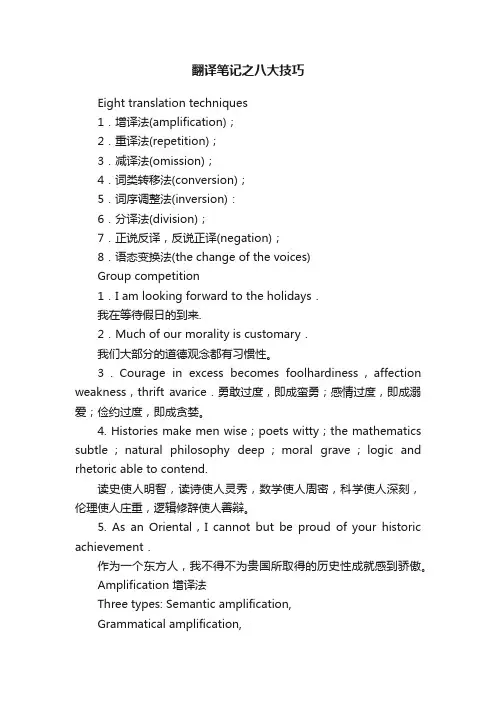
翻译笔记之八大技巧Eight translation techniques1.增译法(amplification);2.重译法(repetition);3.减译法(omission);4.词类转移法(conversion);5.词序调整法(inversion):6.分译法(division);7.正说反译,反说正译(negation);8.语态变换法(the change of the voices)Group competition1.I am looking forward to the holidays.我在等待假日的到来.2.Much of our morality is customary.我们大部分的道德观念都有习惯性。
3.Courage in excess becomes foolhardiness,affection weakness,thrift avarice.勇敢过度,即成蛮勇;感情过度,即成溺爱;俭约过度,即成贪婪。
4. Histories make men wise;poets witty;the mathematics subtle;natural philosophy deep;moral grave;logic and rhetoric able to contend.读史使人明智,读诗使人灵秀,数学使人周密,科学使人深刻,伦理使人庄重,逻辑修辞使人善辩。
5. As an Oriental,I cannot but be proud of your historic achievement.作为一个东方人,我不得不为贵国所取得的历史性成就感到骄傲。
Amplification 增译法Three types: Semantic amplification,Grammatical amplification,Rhetoric amplificationSemantic amplification1. The crowds melted away人群渐渐散开了.2. We were all greatly moved by his loftiness.我们都被他那种崇高品质所深深感染.3. He felt the patriot rise within his breast.他感到一种爱国热情在胸中激荡.loftiness patriot: 英语习惯运用抽象词汇,而汉语习惯运用具体词汇将“抽象概念变为具体概念”,类似词汇如:arrogance, indifference, tension,confusion, solution, remedies, jealousy, fault-finding增补概括性的词1. The advantages of the meeting room are bright, spacious, fashionable, and without echoes.这个会议室有四大优点:明亮、宽敞、时髦、无回声。
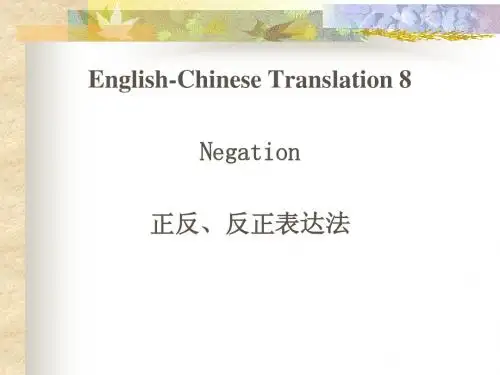
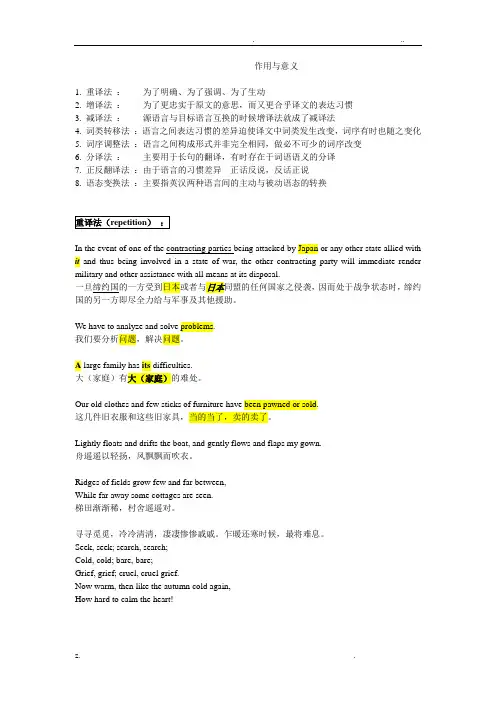
作用与意义1. 重译法:为了明确、为了强调、为了生动2. 增译法:为了更忠实于原文的意思,而又更合乎译文的表达习惯3. 减译法:源语言与目标语言互换的时候增译法就成了减译法4. 词类转移法:语言之间表达习惯的差异迫使译文中词类发生改变,词序有时也随之变化5. 词序调整法:语言之间构成形式并非完全相同,做必不可少的词序改变6. 分译法:主要用于长句的翻译,有时存在于词语语义的分译7. 正反翻译法:由于语言的习惯差异---正话反说,反话正说8. 语态变换法:主要指英汉两种语言间的主动与被动语态的转换In the event of one of the contracting parties being attacked by Japan or any other state allied with it and thus being involved in a state of war, the other contracting party will immediate render military and other assistance with all means at its disposal.一旦缔约国的一方受到日本或者与日本同盟的任何国家之侵袭,因而处于战争状态时,缔约国的另一方即尽全力给与军事及其他援助。
We have to analyze and solve problems.我们要分析问题,解决问题。
A large family has its difficulties.大(家庭)有大(家庭)的难处。
Our old clothes and few sticks of furniture have been pawned or sold.这几件旧衣服和这些旧家具,当的当了,卖的卖了。
Lightly floats and drifts the boat, and gently flows and flaps my gown.舟遥遥以轻扬,风飘飘而吹衣。
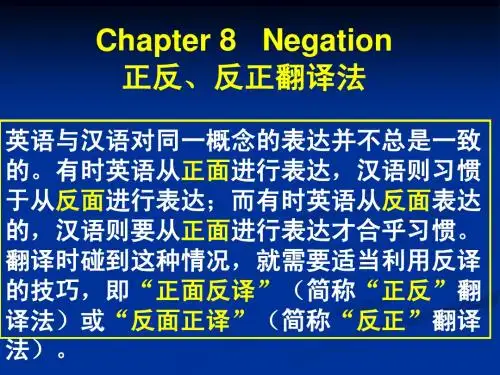

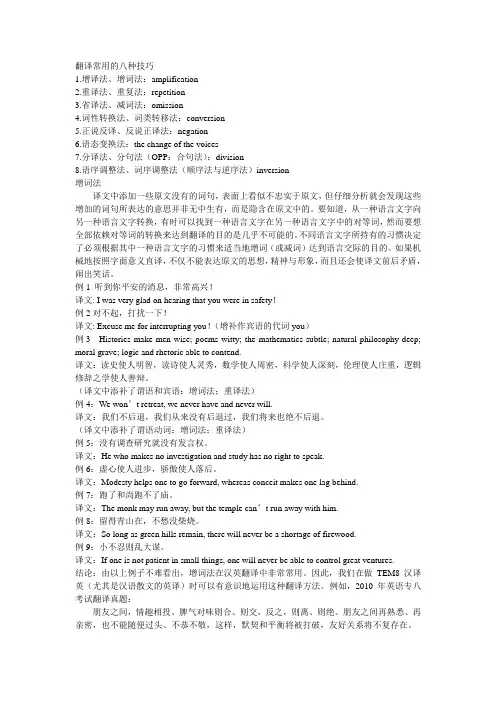
翻译常用的八种技巧1.增译法、增词法:amplification2.重译法、重复法:repetition3.省译法、减词法:omission4.词性转换法、词类转移法:conversion5.正说反译、反说正译法:negation6.语态变换法:the change of the voices7.分译法、分句法(OPP:合句法):division8.语序调整法、词序调整法(顺序法与逆序法)inversion增词法译文中添加一些原文没有的词句,表面上看似不忠实于原文,但仔细分析就会发现这些增加的词句所表达的意思并非无中生有,而是隐含在原文中的。
要知道,从一种语言文字向另一种语言文字转换,有时可以找到一种语言文字在另一种语言文字中的对等词,然而要想全部依赖对等词的转换来达到翻译的目的是几乎不可能的。
不同语言文字所持有的习惯决定了必须根据其中一种语言文字的习惯来适当地增词(或减词)达到语言交际的目的。
如果机械地按照字面意义直译,不仅不能表达原文的思想,精神与形象,而且还会使译文前后矛盾,闹出笑话。
例1 听到你平安的消息,非常高兴!译文: I was very glad on hearing that you were in safety!例2对不起,打扰一下!译文: Excuse me for interrupting you!(增补作宾语的代词you)例3 Histories make men wise; poems witty; the mathematics subtle; natural philosophy deep; moral grave; logic and rhetoric able to contend.译文:读史使人明智,读诗使人灵秀,数学使人周密,科学使人深刻,伦理使人庄重,逻辑修辞之学使人善辩。
(译文中添补了谓语和宾语:增词法;重译法)例4:We won’t retreat, we never have and never will.译文:我们不后退,我们从来没有后退过,我们将来也绝不后退。
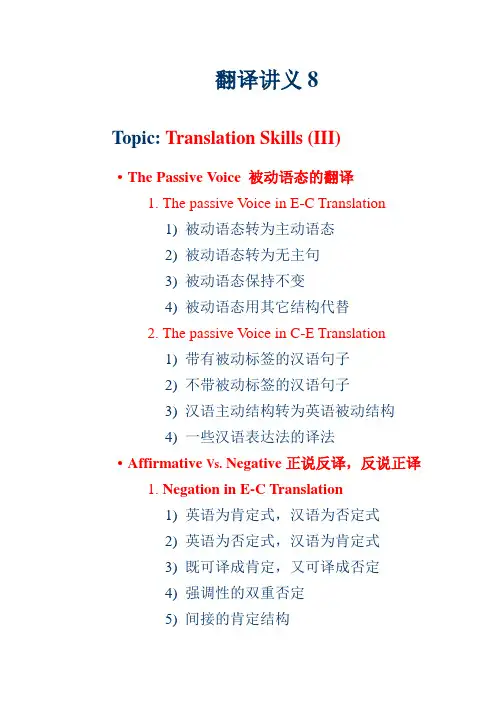
翻译讲义8Topic: Translation Skills (III)·The Passive Voice 被动语态的翻译1.The passive V oice in E-C Translation1)被动语态转为主动语态2)被动语态转为无主句3)被动语态保持不变4)被动语态用其它结构代替2.The passive V oice in C-E Translation1)带有被动标签的汉语句子2)不带被动标签的汉语句子3)汉语主动结构转为英语被动结构4)一些汉语表达法的译法·Affirmative Vs. Negative正说反译,反说正译1.Negation in E-C Translation1)英语为肯定式,汉语为否定式2)英语为否定式,汉语为肯定式3)既可译成肯定,又可译成否定4)强调性的双重否定5)间接的肯定结构6)否定的陷阱2.Negation in C-E Translation1)根据英语的习惯用法译作肯定或否定2)从强调或从修辞角度考虑译作肯定或否定3)为表达出原文的确切意思译作肯定或否定李超·The Passive Voice被动语态的翻译语态有两种,即主动语态和被动语态。
这两种语态在英汉两种语言中的使用情况是很不相同的:英语大量使用被动语态,尤其是科技英语中极为广泛。
而汉语则很少使用,即使使用,也不像英语那样有固定或比较统一的结构或形式。
譬如说,汉语的被动不只是一个“被”字来表示。
因此在英汉互译中要经常变换语态,以使译文符合习惯用法,显得地道而自然。
在英译汉时主要有两种情况,一是必须译为“被”字结构或相似结构,如:“叫……”,“让……”,“给……”,“受到……”,“遭到……”,“为……所……”,“是……的……”,“加以……”等.在总体比例中这种情况所占分量较小。
二是译成内容含被动意味的主动结构或其它结构,这种情况所占分量较大。
而且许多情况下英语被动结构译成汉语时必须灵活处理,摆脱它原来的结构形式,不能一见被动语态就想到“被”。
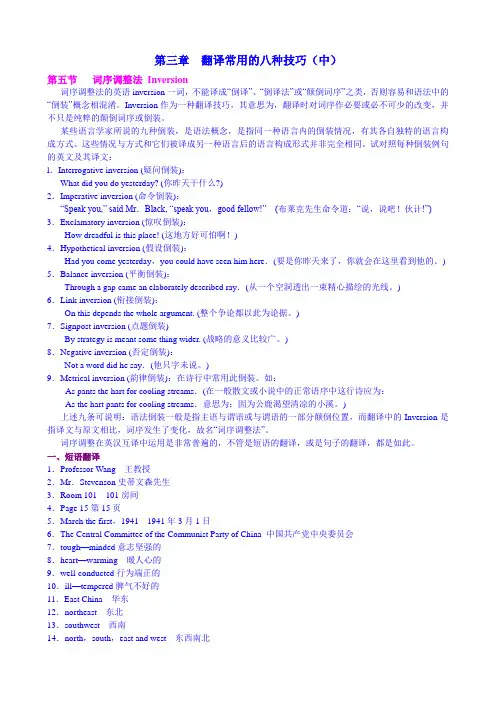
第三章翻译常用的八种技巧(中)第五节词序调整法Inversion词序调整法的英语inversion一词,不能译成“倒译”、“倒译法”或“颠倒词序”之类,否则容易和语法中的“倒装”概念相混淆。
Inversion作为一种翻译技巧,其意思为,翻译时对词序作必要或必不可少的改变,并不只是纯粹的颠倒词序或倒装。
某些语言学家所说的九种倒装,是语法概念,是指同一种语言内的倒装情况,有其各自独特的语言构成方式。
这些情况与方式和它们被译成另一种语言后的语言构成形式并非完全相同。
试对照每种倒装例句的英文及其译文:l.Interrogative inversion (疑问倒装):What did you do yesterday? (你昨天干什么?)2.Imperative inversion (命令倒装):“Speak you,” said Mr.Black, “speak you,good fellow!” (布莱克先生命令道:“说,说吧!伙计!”) 3.Exclamatory inversion (惊叹倒装):How dreadful is this place! (这地方好可怕啊!)4.Hypothetical inversion (假设倒装):Had you come yesterday,you could have seen him here.(要是你昨天来了,你就会在这里看到他的。
) 5.Balance inversion (平衡倒装):Through a gap came an elaborately described ray.(从一个空洞透出一束精心描绘的光线。
)6.Link inversion (衔接倒装):On this depends the whole argument. (整个争论都以此为论据。
)7.Signpost inversion (点题倒装)By strategy is meant some thing wider. (战略的意义比较广。
NegationIt is widely acknowledged that English and Chinese are totally different resulting from thousands of years of separation. Hence, a lot of attention must be paid to translating English sentences when we imply translation skills; suspended at the top of the list, as far as I am concerned, is negation. It is my own belief that a man who know little about the negation in English expression is liable to misunderstand the sentence, what is worse, you may get the utterly opposite idea. Therefore, I would like to analyse the negation in translation in the following aspects.To start with, a negative, in translation, may be transferred from one place to another. For example, we prefer to say “I don’t think he will win” rather than say “I think he will not win”. However, in Chinese, “我不认为他会赢” should give way to “我认为他不会赢”. In this sentence, the negative transfers from the main clause to the subordinate that-clause. Besides, the negative can be transfered in two more cases. For one thing, it can transfer from the finite verb to the adverbial, especially in adverbial clause of cause, eg: He did not come because he wanted to see me.(他来并不是因为想见我) For another, it can transfer to the verb from the other parts of the sentence.In addition, partial negation is another thing we should pay attention to. There are several patterns of partial negation, such as partial affirmative + not, not + full negative, not for nothing, etc. Take a sentence for example, “all men are not born to reign” means “not all men are born to reign”, in other words, some men are born to reign. While full negation is the traditional nagation which we are not likely to misconceive the meaning.When this kinds of sentences are confronted, what is needed is a realization that “no” is much stronger and consequently more emphatic than “not”.What is more, double negation amounts to affirmation. Double negation has two distinct forms: one indicating euphemism and the other emphasis. In the former, we weaken the statement; while in the latter, we strengthen it. Both of them can be translated in an affirmative tone. “Nothing is impossible to a willing mind(有志者,事竟成)” can illustrate this point very well.Furthermore, there are several invisible negative patterns. For example,“If only I met you”means “I haven’t met you”, “This is more than I can say” means “I cann’t say it in words”. Some euphemistic affirmation is equivalent to negation, eg: All music is alike to Tom, in other words, Tom is incapable of appreciating music. Some affirmative idioms also express negative meaning, for instance, “I will buy it” means “I have no idea”.Last but not least, we should take great caution in translating sentences which have negative phrases but express affirmative meaning. Eg. (1)The family were nothing if not happy(the family were fairly happy). (2)We can’t recommend this book strongly enough(we should recommend this book strongly).。
翻译技巧第六讲正说反译,反说正译法正说反译,反说正译法(Negation)Negation is an important composition of any language,but different languages have various ways to express negation, which are reflected not only in the use of negative words but also in different structures of negation.英语的否定形式多种多样——全部否定,部分否定,双重否定,形式否定,意义否定汉语的否定形式单一——negative words are always put before the part to be negated.1.否定转移(1)一般否定——〉特殊否定例1.I don’t teach because teaching is easy for me.我并不是因为教书容易才教书的。
例2.We don’t read novels for amusement.我们读小说不是为了消遣。
例3.The planets do not go around the sun at a uniform speed我们读小说不是为了消遣。
(2)特殊否定——〉一般否定例1.No sound was heard.没有听到声音。
例2.So far we know of no effective way to store solar energy.到目前为止,我们还不知道储存太阳能的有效办法。
2.意义否定的译法所谓意义否定,就是英语中某些形式上是肯定的,但意义上却是否定的句式。
此类句式中,既没有否定词(no,not,none,nothing,nobody,neither,hardly,seldom,rarely,little等),也没有带否定的前缀(dis-,ir-,im-,non-,un-等)的词。
翻译常用的八种技巧一、常用的翻译技巧1. 重复法(repetition)2. 增译法(amplification)3. 减译法(omission)4. 词类转移法(conversion)5. 词序调整法(inversion)6. 分译法(division)7. 正说反译, 反说正译法(negation)8. 语态变换法(the change of the voices)1. 重复法汉语重复,英译时也重复;根据两种语言各自的习惯用法,以不同的表达方式进行重复,这种重复通常是为了传达原文的生动性.We have to analyze and solve problems.我们要分析问题,解决问题。
Let’s revise our safety and sanitary regulations.我们来修改安全规则和卫生规则吧。
Gentlemen may cry, peace, peace --- but there is no peace.先生们尽管可以高呼和平,和平!但是依然没有和平。
Nels had it all written out neatly.纳尔斯把它写得清清楚楚。
青青河边草, 郁郁园中柳。
Green grows the grass upon the bank,The willow shoots are long and lank.2. 增译法为了使译文忠实地表达原文的意思与风格并使译文合乎表达习惯,必须增加一些词语,这就叫增译法.增词义增加虚词为多,也可酌量增加实词。
英译汉时经常增加的词有结构词、数量词、概念词、语气词等。
从增补的功能来看,可以分为结构增补、意义增补和修辞增补。
I am looking forward to the holidays.我们等待假日的到来。
Much of our morality is customary.我们大部分的道德观念都有习惯性。
Reading makes a full man; conference a ready man; and writing an exact man.读书使人充实,讨论使人机智,笔记使人精确。